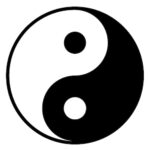Today’s poetic interconnection is inspired by the Chinese Tai Chi symbol:

This classic Taoist sign illustrates the dynamic relationship between yin and yang. These archetypes of passivity and activity, rest and energy, constantly flow into and back out of each other. And even when one is dominating, a spot of the other remains right in the middle.
Together, yin and yang characterize the fundamental tao—the full circle, ever in fluid motion.
Carl Jung was a pioneering psychologist who believed that the human personality was characterized by two similar elements: anima and animus. Anima is the feminine, connective, and passive element of the psyche, and animus is the masculine, discriminative, and active element. Jung taught that men’s psyches are balanced and “compensated” by their anima, and women’s by their animus.
Jung thought anima and animus to be timeless expressions of the collective unconscious, the part of the psyche that transcends personal identity. He believed dream symbols, myths, and other common human characteristics, beliefs, and patterns of behavior come from this shared field of consciousness.
Anima and animus seem to me to be smoothly comparable with yin and yang. And Jung’s collective unconscious sounds a lot like the fundamental tao.
Let’s re-imagine the Tai Chi symbol, then, as an emblem depicting the human psyche, with anima and animus swirling and interpenetrating, and the full circle symbolizing the complete self in dynamic balance.
Neils Bohr, a primary architect of quantum theory, included the Tai Chi in his Danish coat-of-arms, using it to represent his principle of complementarity which asserts that all quantum phenomena require two simultaneous types of description: one appropriate to waves and one appropriate to particles. He developed his principle after experiments revealed that quanta display characteristics of both, which is an ongoing mystery, as waves and particles were previously thought to be mutually exclusive modes of matter.
Waves passively intermix when they encounter one another, making them analogous to yin and anima. Particles actively bounce off one another when they meet, or they break up into smaller particles. Either way, they remain discrete, like yang and animus.
Contemporary physicists theorize that all quanta spring from a foundational field of physical energy known as the Zero Point Field. This field can be visualized either as a cool sea of interweaving waves or a boiling body of water from which particles bubble up.
The quantum ZPF is thus another ground with dual characteristics, like the tao and Jung’s collective unconscious.
And so I’m led to ask these questions: Is science only recently discovering a reality that mystics and philosophers have intuited for millennia? Is physics confirming metaphysics? And if so, should that strengthen our trust in less empirical ways of parsing the world?



This was the first “poeticinterconnections” message I received I don’t exactly know how I ended up on this list but I was curious and didn’t declare it spam. At least for a while I’ll lsee what comes up.
The I Ching has been of interest to me for a long time although I really don’t know too much about it….. But I suspect, from my involvement with the Talmud, and the Zohar, that translations differ enormously and to see that text in the context of the ancient world from when it originated is of utmost importance.
I look forward to seeing what else you have posted.
Adam….Atman, A Brahman….Abraham. Yin, Yang & Jung….All for One & One for All(ah?) The Cosmos is NOT cold….It has a sense of humor…Man! Can “man” mess things up?
Nice, thanks for the comment!